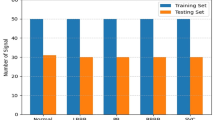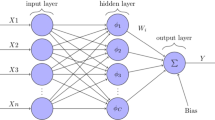Abstract
For identifying nonlinear discrete systems, a new Hammerstein model consisting of Volterra neural network (VNN) and infinite impulse response (IIR) digital system is developed in this paper. The nonlinear static part of Hammerstein model is the proposed VNN structure that is a combination of the Volterra digital system and feedforward neural network. Another linear dynamic part in the model is expressed by the IIR digital filter. To design weights and thresholds contained in VNN and filter coefficients in IIR, a popular particle swarm optimization (PSO) algorithm is adopted such that the model output is able to approximate the actual nonlinear system output. Finally, many examinations including different population sizes and initial conditions are performed for two nonlinear system examples. All of simulation data including the mean squared error and sum of squared error derived by the proposed method are superior to those by other existing design methods. These sufficiently show the excellent performance of the developed Hammerstein model with PSO tuning on the nonlinear discrete systems modeling.













Similar content being viewed by others
Data availability
Enquiries about data availability should be directed to the authors.
References
Abbasi E, Ghatee M, Shiri ME (2013) FRAN and RBF-PSO as two components of a hyper framework to recognize protein folds. Comput Biol Med 43:1182–1191
Abrahamsson R, Kay SM, Stoica P (2007) Estimation of the parameters of a bilinear model with applications to submarine detection and system identification. Digital Signal Process 17:756–773
Ahn CK (2014) Receding horizon disturbance attenuation for Takagi–Sugeno fuzzy switched dynamic neural networks. Inf Sci 280:53–63
Amer M, Namaane A, M’Sirdi NK (2013) Optimization of hybrid renewable energy systems (HRES) using PSO for cost reduction. Energy Procedia 42:318–327
Casenave C (2011) Time-local formulation and identification of implicit Volterra models by use of diffusive representation. Automatica 47:2273–2278
Chang WD (2012) Differential evolution-based nonlinear system modeling using a bilinear series model. Appl Soft Comput 12:3401–3407
Chen J, Wang X, Ding R (2012) Gradient based estimation algorithm for Hammerstein systems with saturation and dead-zone nonlinearities. Appl Math Model 36:238–243
Cheng Y, Zhang H, Zhang W, Zhang H (2021) Novel algebraic criteria on global Mittag-Leffler synchronization for FOINNs with the Caputo derivative and delay. J Appl Math Comput. https://doi.org/10.1007/s12190-021-01672-0
Couchman IJ, Kerrigan EC, Bohm C (2011) Model reduction of homogeneous-in-the-state bilinear systems with input constraints. Automatica 47:761–768
Cui M, Liu H, Li Z, Tang Y, Guan X (2014) Identification of Hammerstein model using functional link artificial neural network. Neurocomputing 142:419–428
Ding F, Liu XP, Liu G (2011) Identification methods for Hammerstein nonlinear systems. Digital Signal Process 21:215–238
El-Abbasy MS, Senouci A, Zayed T, Mirahadi F, Parvizsedghy L (2014) Artificial neural network models for predicting condition of offshore oil and gas pipelines. Autom Constr 45:50–65
Figueiredo EMN, Ludermir TB (2014) Investigating the use of alternative topologies on performance of the PSO-ELM. Neurocomputing 127:4–12
Hong X, Chen S (2012) The system identification and control of Hammerstein system using non-uniform rational B-spline neural network and particle swarm optimization. Neurocomputing 82:216–223
Hsieh YZ, Su MC, Wang PC (2014) A PSO-based rule extractor for medical diagnosis. J Biomed Inform 49:53–60
Huo HB, Zhu XJ, Hu WQ, Tu HY, Li J, Yang J (2008) Nonlinear model predictive control of SOFC based on a Hammerstein model. J Power Sources 185:338–344
Le F, Markovsky I, Freeman CT, Rogers E (2012) Recursive identification of Hammerstein systems with application to electrically stimulated muscle. Control Eng Pract 20:386–396
Modares H, Alfi A, Sistani MBN (2010) Parameter estimation of bilinear systems based on an adaptive particle swarm optimization. Eng Appl Artif Intell 23:1105–1111
Mosleh M (2013) Fuzzy neural network for solving a system of fuzzy differential equations. Appl Soft Comput 13:3597–3607
Namda SJ, Panda G, Majhi B (2010) Improved identification of Hammerstein plants using new CPSO and IPSO algorithms. Expert Syst Appl 37:6818–6831
Nguyen SD, Ngo LN, Tran QT, Choi SB (2013) A new method for beam-damage-diagnosis using adaptive fuzzy neural structure and wavelet analysis. Mech Syst Signal Process 39:181–194
Otadi M (2014) Fully fuzzy polynomial regression with fuzzy neural networks. Neurocomputing 142:486–493
Panda S, Mohanty B, Hota PK (2013) Hybrid BFOA–PSO algorithm for automatic generation control of linear and nonlinear interconnected power systems. Appl Soft Comput 13:4718–4730
Schmidt CA, Biagiola SI, Cousseau JE, Figueroa JL (2014) Volterra-type models for nonlinear systems identification. Appl Math Model 38:2414–2421
Senouci A, Boukabou A (2014) Predictive control and synchronization of chaotic and hyperchaotic systems based on a T-S fuzzy model. Math Comput Simul 105:62–78
Solis AR, Panoutsos G (2013) Granular computing neural-fuzzy modeling: a neutrosophic approach. Appl Soft Comput 13:4010–4021
Stamova IM, Stamov T, Simeonova N (2014) Impulsive effects on the global exponential stability of neural network models with supremums. Eur J Control 20:199–206
Tang Y, Li Z, Guan X (2014) Identification of nonlinear system using extreme learning machine based Hammerstein model. Commun Nonlinear Sci Numer Simul 19:3171–3183
Van de Vegte J (2001) Fundamentals of digital signal processing. Prentice Hall, New Jersey
Yang YS, Chang WD, Liao TL (2012) Volterra system-based neural network modeling by particle swarm optimization approach. Neurocomputing 82:179–185
Zhang C, Huang N, O’Regan D (2013) Almost periodic solutions for a Volterra model with mutual interference and Holling type III functional response. Appl Math Comput 225:503–511
Zhang C, Feng G, Qiu J, Zhang WA (2014) T-S fuzzy-model-based piecewise output feedback controller design for networked nonlinear systems with medium access constraint. Fuzzy Sets Syst 248:86–105
Zhang H, Ye M, Ye R, Cao J (2018a) Synchronization stability of Riemann–Liouville fractional delay-coupled complex neural networks. Physica A 508:155–165
Zhang H, Ye R, Liu S, Cao J, Alsaedi A, Li X (2018b) LMI-based approach to stability analysis for fractional-order neural networks with discrete and distributed delays. Int J Syst Sci 49:537–545
Zhang H, Ye R, Cao J, Alsaedi A (2018c) Delay-independent stability of Riemann–Liouville fractional neutral-type delayed neural networks. Neural Process Lett 47:427–442
Zhang H, Cheng J, Zhang H, Zhang W, Cao J (2021) Quasi-uniform synchronization of Caputo type fractional neural networks with leakage and discrete delays. Chaos Solitons Fractals 152:111432
Acknowledgements
This work was partially supported by the Ministry of Science and Technology of Taiwan under Grant MOST 108-2221-E-366-003.
Funding
The authors have not disclosed any funding.
Author information
Authors and Affiliations
Corresponding author
Ethics declarations
Conflict of interest
The author declares that he has no conflict of interest.
Ethical approval
This article does not contain any studies with human participants or animals performed by the author.
Additional information
Publisher's Note
Springer Nature remains neutral with regard to jurisdictional claims in published maps and institutional affiliations.
Rights and permissions
About this article
Cite this article
Chang, WD. Identification of nonlinear discrete systems using a new Hammerstein model with Volterra neural network. Soft Comput 26, 6765–6775 (2022). https://doi.org/10.1007/s00500-022-07089-6
Accepted:
Published:
Issue Date:
DOI: https://doi.org/10.1007/s00500-022-07089-6




